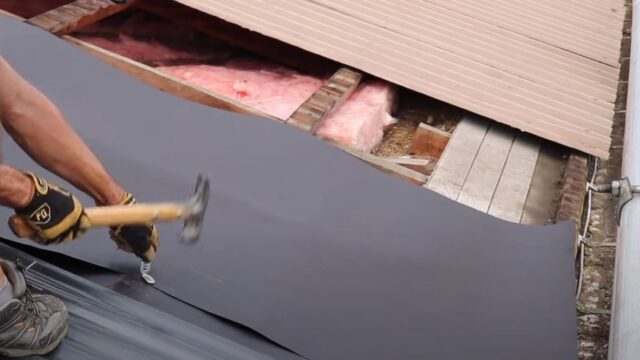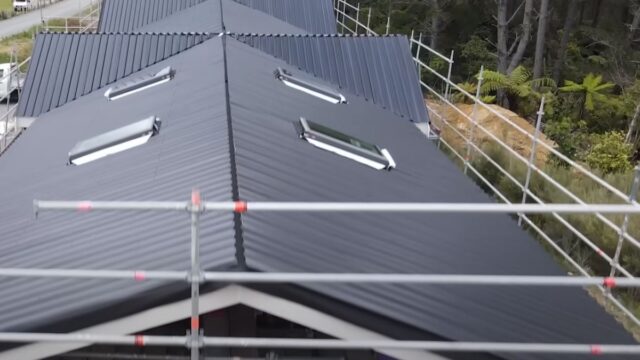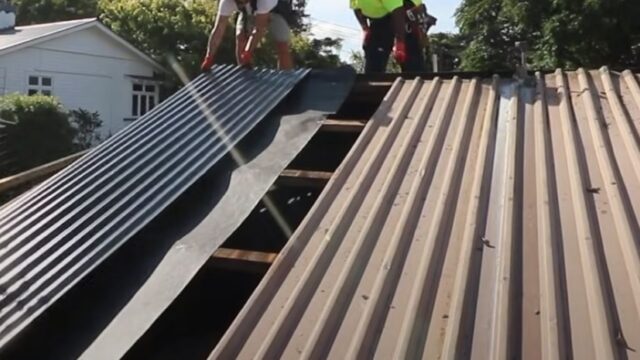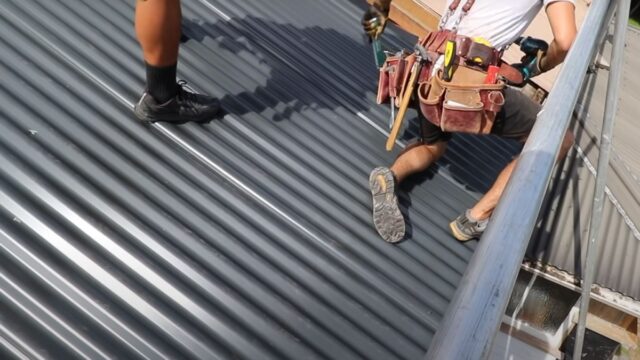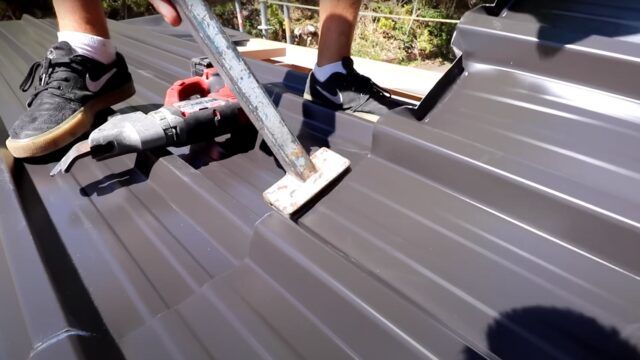Cost Factors of Reroofing a House in NZ
Materials and Their Costs
The cost of reroofing a house in NZ depends on several factors, one of which is the choice of materials. Common materials for roofing in New Zealand include asphalt shingles, metal roofing, concrete tiles, and clay tiles. Each material has its own price point:
- Asphalt shingles: NZ$70 – NZ$120 per square metre
- Metal roofing: NZ$50 – NZ$100 per square metre
- Concrete tiles: NZ$60 – NZ$100 per square metre
- Clay tiles: NZ$80 – NZ$180 per square metre
These prices can vary depending on the brand, quality, and style of the materials chosen.
Labour and Installation Costs
Labour and installation costs for reroofing a house in NZ typically range from NZ$40 to NZ$70 per hour. However, these costs can vary depending on factors such as the complexity of the project, the roof’s slope and height, and the contractor’s experience. It is essential to get multiple quotes from different contractors to ensure a fair price. And please note, these prices are subject to change given the current macro-economic environment impact NZ pricing.
Regional Price Differences
The cost of reroofing a house in NZ can also vary depending on the location. For instance, reroofing projects in urban areas like Auckland may have higher labour costs compared to those in more rural areas. Additionally, regional materials availability and shipping costs can affect the overall expenses.
Auckland Relevant Regulations and Local Bylaws
In Auckland, there are regulations and local bylaws that homeowners must adhere to when undertaking a reroofing project. The Auckland Unitary Plan outlines these requirements, affecting suburbs such as Central Auckland, North Shore, West Auckland, and South Auckland.
Some of the regulations that homeowners in Auckland should be aware of include:
- Obtaining a building consent from the Auckland Council if the reroofing project involves structural alterations or changes to the roof slope
- Ensuring that the roofing materials and installation practices comply with the New Zealand Building Code
- Adhering to heritage protection regulations if the property is located within a heritage or special character area
It is vital for homeowners to be aware of and comply with these regulations and local bylaws to avoid potential fines and complications during their reroofing project.
Types of Roofing Materials
Metal Roofing Options
Metal roofing materials are popular in New Zealand due to their durability and resistance to various weather conditions. Steel roofing and corrugated iron are commonly used for their strength and affordability. Metal tiles offer the aesthetics of traditional tiles while maintaining the benefits of metal roofing. Another luxury option is copper roofing, which boasts a long lifespan and unique appearance but comes with a higher price tag.
Tile Roofing Options
Tile roofing materials are known for their visual appeal and versatility. Clay tiles are a favoured choice due to their natural, classic look and ability to withstand harsh conditions. Concrete tiles are also well-liked in New Zealand for their affordability and easy installation. Both clay and concrete tiles are available in different styles and colours, allowing homeowners to personalize their roof to match their home’s design.
Asphalt
Asphalt shingles are a popular roofing material in many countries, although not as prevalent in New Zealand. They come in various styles, colours, and price ranges, making them a versatile option for homeowners. Asphalt shingles provide good weather resistance and are relatively easy to install but may not be as long-lasting as other materials, such as metal or tiles.
Slate
Slate roofing is a high-end choice for homeowners looking for elegance and durability. Known for its beauty and longevity, slate requires skilled installation and comes at a premium price. Additionally, the weight of slate can be a limiting factor for some homes, as not all structures can support the added load.
Other Materials
Membrane roofing is another option for homeowners to consider, particularly for flat or low-slope roofs. Thermoplastic polyolefin (TPO) and ethylene propylene diene monomer (EPDM) are common membrane materials, offering weather resistance and low maintenance requirements.
Auckland Regulations and Local Bylaws
When reroofing a house in Auckland, it is essential to be aware of local regulations and bylaws that may affect the project. The Auckland Unitary Plan and the Building Act 2004 govern construction requirements and standards to ensure the safety and quality of newly installed roofs.
Homeowners must obtain the appropriate building consents before commencing any reroofing work. Some Auckland suburbs, such as Parnell, Ponsonby, and Devonport, have additional bylaws covering the preservation of local character. In these areas, the choice of roofing materials and styles may be subject to restrictions or additional requirements to maintain the historical or cultural design of the suburb.
Considering the local context of Auckland in terms of regulations and bylaws is crucial for any reroofing project. Homeowners should consult with knowledgeable professionals to ensure their reroofing project complies with all relevant rules and guidelines.
Selecting the Right Roofing Material
When a homeowner in Auckland decides to reroof their house, one crucial decision they have to make is selecting the right roofing material. This choice can significantly impact the budget, design, energy efficiency, and durability of the roof. Furthermore, considerations such as maintenance, colour, appeal, and value should not be overlooked.
In evaluating different materials, durability plays a significant role. High-quality materials that are long-lasting help ensure a homeowner gets a return on their investment. Maintenance is another important factor, as it translates to the amount of time, effort, and money a homeowner needs to dedicate to keeping their roof in good condition. A material that requires less maintenance is more desirable.
From a design perspective, the colour and aesthetic appeal of the roofing material can elevate the overall look of a house. Homeowners should consider how the roof will blend in with the surrounding environment and how the chosen material complements the house design.
Energy efficiency is not to be downplayed. Materials that insulate well help reduce energy consumption and save on utility bills. A more energy-efficient roof can also add value to a home, which is worth considering for future resale or potential rental income.
Specific regulations and local bylaws in Auckland must be factored in when reroofing. These regulations might affect material choices or application methods in certain suburbs. Familiarize yourself with these laws to avoid any legal complications or penalties.
When selecting a roofing material, homeowners in Auckland should consider:
- Durability
- Maintenance requirements
- Design compatibility
- Colour options
- Energy efficiency
- Regulation and bylaw compliance
- Potential to increase property value
By carefully considering these factors, one can ensure they make an informed decision when it comes to choosing the right roofing material for their house in Auckland.
Considerations for Reroofing vs. Repair
When deciding whether to repair or replace your roof, several factors come into play. These factors include the age and current condition of your roof, the extent of damages, and how it has been maintained over time. By carefully considering all of these aspects, homeowners can make well-informed decisions about their home’s roofing needs.
Roof age is one of the primary factors to think about before taking any action. Most roofs in New Zealand have a lifespan of 15 to 20 years, depending on the materials and workmanship. Signs of wear and tear begin to appear as your roof nears the end of its life, suggesting that it may be more economical to invest in a new roof rather than repair. A quick inspection of the roof can give clues about the remaining life, such as curling of shingles, loss of granules, or sagging of the structure.
The condition of the roof is another important aspect to consider. Roof maintenance plays a significant role in its longevity. A well-maintained roof will require fewer repairs, and when repairs are needed, they are often minor and more manageable. Leaks, missing shingles, and water damage are common issues that can be addressed with repairs. However, extensive damage or deterioration may warrant a full roof replacement.
Assessing the extent of damage is essential in making the repair or replacement decision. Minor damages, such as a few missing shingles or a single leak, can easily be fixed through roof repairs. On the other hand, extensive water damage or multiple leaks may require a more comprehensive solution, like a complete roof replacement. In some cases, the cost of multiple repairs can equal or exceed the cost of a new roof, so taking the time to evaluate the situation carefully is crucial.
Relevance to Auckland readers:
In Auckland, local regulations and bylaws influence how homeowners address roofing needs. The Auckland Unitary Plan outlines specific requirements for new constructions, alterations, and additions in different suburbs, affecting decisions like roof replacement. Homeowners should familiarize themselves with these regulations to make the most appropriate choice for their specific location. For example, specific rules apply to properties in heritage zones, coastal areas, or near significant ecological areas.
By considering factors like age, condition, and the extent of damage, homeowners can weigh the pros and cons of reroofing versus repairing. Staying informed about local regulations and neighborhood characteristics will further assist Auckland homeowners in making the best decision for their home.
Roofing Contractor Selection
Selecting the right Auckland roofing contractor is a crucial decision in any reroofing project. To ensure quality installation and the longevity of the roof, homeowners should obtain multiple quotes from reputable tradespeople. Taking the time to research and compare contractors, examining their experience and past projects, can help save time and money in the long run.
One of the first steps in selecting a roofing contractor is to obtain at least three quotes. Each quote should detail the project scope, materials to be used, and a schedule for the installation. Comparing these quotes will allow homeowners to have a clear understanding of the costs associated with the project. Moreover, homeowners can consider factors such as the contractor’s reputation, quality of work, and any additional services they might offer.
In Auckland, specific regulations and local bylaws govern reroofing projects. Homeowners should be aware of these regulations, particularly in suburbs such as North Shore, Waitakere, and Manukau City. These rules may impact factors such as the choice of roofing materials, installation requirements, and building permits. A knowledgeable roofing contractor will be familiar with these regulations and can help ensure that the project meets all necessary compliance standards.
When considering a roofing contractor, it is essential to check their credentials and any professional affiliations. Contractors who are members of industry associations, such as the Roofing Association of New Zealand (RANZ), display a commitment to quality, training, and adherence to industry standards. Additionally, homeowners should seek out references or testimonials from past clients to gauge the contractor’s reliability and the quality of their work.
Pricing variables may change over time due to fluctuations in the New Zealand Consumer Price Index (CPI) and other market factors. While specific figures may be out of date, the overall cost considerations and guidelines related to reroofing projects remain relevant.
In summary, choosing the right roofing contractor can make a significant difference in the success and final outcome of a reroofing project. By obtaining multiple quotes, researching contractors, and considering local regulations and bylaws, homeowners in Auckland can make well-informed decisions and enjoy a high-quality, durable new roof.
Reroofing Process and Timeline
The process of re-roofing involves various stages, starting from the initial assessment of the structure to the project’s completion. To ensure safety and proper execution, scaffolding is often set up around the building, taking into consideration the pitch of the roof and the height of the structure.
During the re-roofing process, the removal of the existing cladding and other roofing materials is undertaken. Disposal of these materials is another critical aspect, with some components being recyclable while others require proper handling and disposal according to regulations.
Once the old roofing materials have been removed, a thorough inspection of the underlying structure helps identify any issues that may need to be addressed before installing the new roof. Then, the new cladding is put in place, sealing the roof against weather elements and ensuring energy efficiency.
In Auckland, specific regulations govern re-roofing projects. It is important to be aware of these regulations and any local bylaws that may affect the work. For instance, particular suburbs may have unique requirements regarding the materials used or the design aesthetic that needs to be maintained. Being locally relevant to Auckland readers, it can be helpful to consult with an expert familiar with the area’s bylaws and regulations to ensure smooth and compliant project execution.
When it comes to pricing, factors such as the type of roofing materials used, the roof’s size and pitch, and any additional structural repairs needed can affect the overall cost. It is essential to keep in mind that pricing variables can change over time, so it’s always a good idea to obtain accurate and up-to-date quotes from roofing contractors.
In conclusion, the reroofing process and timeline will depend on various factors, such as the building’s structure, the materials used, and any relevant regulatory requirements. By understanding these elements and working with knowledgeable professionals, homeowners can ensure a successful re-roofing project in Auckland.
Additional Features and Components
When considering the cost of reroofing a house, it’s essential to account for additional features and components that can impact the overall expense. In this section, we will explore the most common factors that may affect the cost of reroofing in New Zealand, with a particular focus on Auckland’s specific regulations and local bylaws.
Underlay and Insulation: The cost of reroofing your house may vary depending on the type of underlay and insulation materials you choose. For instance, some homeowners opt for synthetic underlays which tend to be more expensive than traditional felt underlays. Additionally, upgrading your roof’s insulation can also affect the final price. Better insulation can provide energy savings in the long run, though it might come with a higher upfront cost.
Skylights and Flashings: Integrating skylights or replacing existing ones during a reroofing project can increase the overall cost. The price for installing skylights typically depends on their dimensions and materials. Similarly, installing or replacing flashings is crucial to ensure proper waterproofing and weather-resistance of the roof. The cost will vary based on the type and amount of flashing material required.
Profile and Finish: Different roofing materials have various profiles, which can affect the overall aesthetic of a house. The chosen profile and finish will impact the price of reroofing. For example, corrugated metal roofs are generally more affordable than standing seam or tile roofs. Additionally, selecting a specific finish, like color-coating or powder-coating, might add to the total cost.
Height and Access: The height and accessibility of the house can impact the reroofing project’s overall price. Taller buildings or houses with narrow or limited access points may require additional scaffolding, safety measures, and specialized equipment, which can increase costs compared to a more accessible property.
In Auckland, local authorities regulate the construction and maintenance of roofing systems to ensure the safety and quality of housing. For instance, building consent is required for projects that involve structural changes or weather-tightness alterations, affecting suburbs like North Shore, Waitakere, and Manukau. It’s crucial to consult the Auckland Council’s guidelines and bylaws to ensure your reroofing project complies with local regulations.
Given the many variables that can affect the cost of reroofing a house in New Zealand and the specific regulations in Auckland, it is essential to obtain multiple quotes from reputable contractors to gauge an accurate estimate tailored to your needs. Taking time to research and plan your reroofing project can result in a long-lasting and high-quality result that increases the value and comfort of your home.
Legal and Building Code Requirements
When considering reroofing a house in New Zealand, it’s essential to be aware of the legal and building code requirements that apply to both residential and commercial properties. The New Zealand Building Code (NZBC) provides guidelines that must be adhered to when undertaking construction or renovation activities, including reroofing.
In addition to the NZBC requirements, Auckland has specific regulations that impact certain suburbs. Knowing and understanding these local bylaws is crucial for a successful reroofing project. The Auckland Unitary Plan outlines zoning rules and property restrictions that can influence the type of roofing materials or construction methods allowed in specific areas.
In general, legal and building code requirements for reroofing in NZ include:
- Obtaining the necessary consents and permits: Before beginning any significant construction work, property owners need to apply for and obtain the appropriate consents and permits from their local council. This ensures that all proposed changes are compliant with NZBC and local regulations.
- Meeting performance requirements: The NZBC mandates several performance requirements related to roofing, such as durability, structural integrity, insulation, and weather resistance. All reroofing projects need to meet or exceed these performance standards.
- Using compliant materials: The choice of roofing materials should be compliant with NZBC guidelines and local regulations. Some areas have restrictions on materials due to environmental concerns or aesthetic considerations. This is especially relevant in Auckland, where certain suburbs have specific rules regarding roofing materials and styles.
- Ensuring safe work practices: Compliance with health and safety regulations is essential during a reroofing project. Proper measures must be in place to protect workers, occupants, and the public from potential risks associated with construction activities.
Keep these legal and building code requirements in mind when planning a reroofing project in New Zealand, particularly in Auckland. Following the NZBC guidelines and local bylaws will help ensure a smooth, compliant, and successful project for both residential and commercial properties.
The Impact of Reroofing on Property Value
Reroofing a house significantly affects its property value. Potential buyers often consider the condition of the roof when deciding on a property to purchase in the New Zealand market. A well-maintained roofing system not only adds appeal to the property but also ensures a healthy living environment, free from leaks and potential damages.
A key factor in maintaining a property’s value is energy efficiency. Investing in a new roof, particularly one with modern, energy-efficient materials, can reduce energy consumption and electricity costs. This makes the property more attractive to eco-conscious buyers, and ensuring that the energy savings contribute to a higher overall value.
In Auckland, local regulations and bylaws regarding reroofing vary depending on the suburb. Some suburbs have specific requirements related to the materials used or the building’s historical significance. Homeowners must familiarize themselves with these regulations before making any reroofing plans. Complying with local bylaws and regional requirements ensures a smoother reroofing process and a higher potential value increase.
Another aspect to consider is the choice of roofing materials. Different materials carry varying costs, levels of durability, and energy efficiency ratings. By selecting the right materials for a specific property type and location, homeowners can substantially increase the property’s appeal and value.
For instance, the following materials are commonly used in New Zealand roofing:
- Asphalt shingles
- Metal roofing
- Clay and concrete tiles
- Slate
- Wooden shingles and shakes
It is important to weigh the pros and cons of each material, such as affordability, durability, and aesthetics, so that they meet the needs and desires of prospective buyers. When reroofing a house, it is crucial to consider both the short-term and long-term ramifications on the property’s value. A properly executed reroofing project, compliant with local regulations, utilizing high-quality materials, and focusing on energy-efficiency, can lead to a significant increase in the overall value and market appeal of the property.
